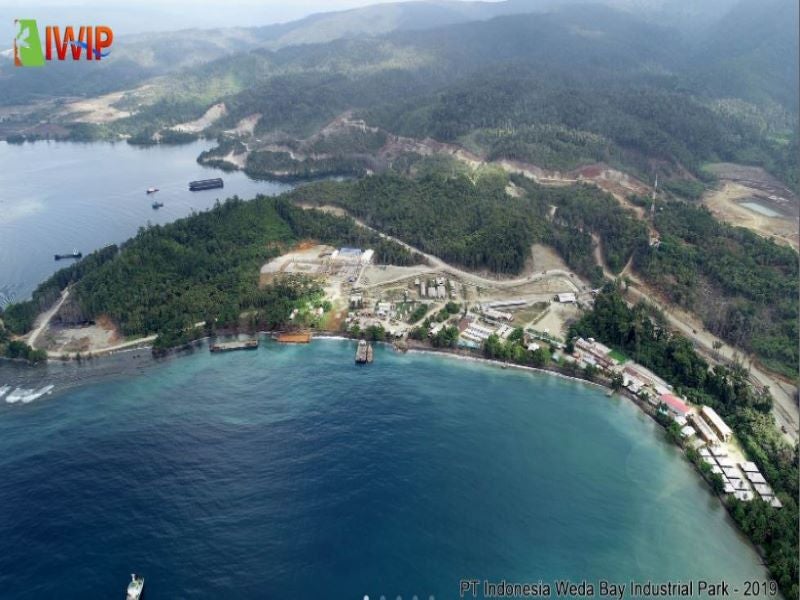The Weda Bay nickel project is an open-pit nickel-cobalt mining operation located in the Halmahera Island of Indonesia. It is owned and operated by Weda Bay Nickel, a joint venture partnership between French mining and metallurgy company Eramet (43%) and China’s Tsingshan Holding Group (57%).
The nickel laterite deposits on the Halmahera Island were first discovered in 1996 while the Weda Bay Nickel company was established as a joint venture between Canada-based Weda Bay Minerals (90%) and Indonesia’s Antam (10%) in the following year.
Although Eramet acquired the property from Weda Bay Capitals in 2006, the project was put on hold Eramet’s partner Mitsubishi Corporation withdrawing from the project in 2013.
In 2017, Eramet signed an agreement with Tsingshan under which the Chinese stainless steel company took over the construction and operation of the processing infrastructure facilities while Eramet was in charge of the mining operations.
Mining operations at the Weda Bay nickel project were started in October 2019 while the first ferronickel product was successfully casted in April 2020.
The ferronickel output from the project reached 4.2 thousand tonnes (Kt) by June 2020 and the mine life estimated to last up to 50 years.
Project location and geology
The Weda Bay nickel project is in the central region of Halmahera Island in the North Maluku province of Indonesia. Situated approximately 70km away from the provincial capital of Ternate, the project area covers approximately 54,874 hectares.
The Weda Bay nickel property is dominated by ultramafics and microgabbros with volcanics and pelagic sediments occurring in minor segments.
The geological units occur as a north-south trending series of tectonic slices separated by vertical to sub-vertical faults. The ultramafics make up approximately 30% of the basement complex and host the bulk of the laterite mineralisation, dominated by harzburgite, dunite, cumulate chromite-dunite bodies, and basalt dykes.
Mineralisation and reserves
The primary mineralisation at Weda Bay occurs in hazburgites and dunites as nickel rich olivine, enstatie and chromite. The ultramafic basement rocks have an average nickel grade of 0.28% and the nickel-rich olivine forms various secondary nickel-iron rich minerals concentrated in residual and supergene enrichment.
The laterite segment has an average thickness of 10m with 8m of the mineralised zone featuring nickel grades in excess of 1%.
The Weta Bay nickel project is estimated to contain approximately 344 million tonnes (Mt) of ore reserves of grading 1.48% nickel and 0.07% cobalt.
Mining operations
The Weda Bay nickel project will utilise open-pit mining methods with a total of eight pits including six small pits and two large pits to be developed over the mine life.
The large pit developments will focus on the Bukit Limber Barat and the Bukit Limber Timur deposits.
The small pits will be based on the coastal deposits of Nuspera, Uni Uni, Biri-Biri Barat, Biri-Biri Timur, Sake Barat, Ake Sake, as well as the northern province deposit of Tofu Bleuwen. The small pits in combination will provide up to 40% of the ore output for the project.
The open-pit mining will be carried out on 4m-hgh benches while the berm widths will be 5m with the slopes between the berms at 60°.
The mine fleet comprises 80t excavators and 40t loaders supported by haul trucks. Blasting is not required due to the shallow nature of the deposits.
Weta Bay industrial park
The Weda Bay industrial park is an integrated complex to facilitate mineral processing, smelting, and the production of EV batteries with ore supplied by the Weda Bay mines. The park is located in Weda, Central Halmahera Regency, North Moluccas Province, Indonesia.
The construction activities started in August 2018 and the park currently has four pyrometallurgical production lines to produce nickel ferroalloy that have been operational since May 2020.
The development of a nickel and cobalt hydrometallurgical refining complex that would include a high-pressure acid leaching (HPAL) plant and a base metal refinery (BMR) is also currently underway.
The Weda Bay industrial park will also include the construction of a ferronickel smelter with estimated annual production capacity of up to 300, 000t.
Contractors involved
The contract for the construction of the ferronickel smelter has been awarded to PT Yashi Indonesia Investment, a joint venture between Zhenshi Holding Group, Shanghai Decent Investment Group, and Zhejiang Huajun Investment.
A joint agreement was signed between Eramet and BASF Catalysts to assess the development of the nickel and cobalt hydrometallurgical refining complex.
The construction contract for the construction of the Furnace No. 4 at the Weda Bay industrial park was awarded to China First Metallurgical Construction Group (CFMCC).





